George F. Smoot
Biographical
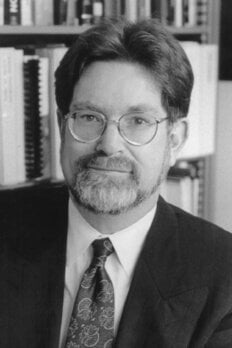
Winning a Nobel Prize is a life-changing event. It is a turning point. In addition to many people asking about how you arrived at this point, the winner is asked to produce his biography. All this and the events related to the Nobel Prize have resulted in each one of us going back and reviewing his life and influences that led to the present.
There were many key people, events and circumstances that had a substantial effect upon my development. However, it is clear that family has by far had the largest effect.
Both of my grandfathers were judges, along with my uncle and my cousin. One grandfather, Tal Crawford, served as Chief Justice during the Nuremberg War Crimes trial. Although I knew him only as a child, he had an influence upon me directly from his great kindness and careful discussions, and also through my mother Talicia. My father even started college with the intent to major in law, but World War II and interest in engineering and science diverted him.
Another key person was my Ph.D. thesis advisor at MIT, Professor David Henry Frisch. I was recently at a meeting with his son, University of Chicago Physics Professor Henry Frisch, and recalled how Professor Frisch related from time to time how he had descended from thirteen generations of rabbis, and that now there were two generations of physicists. (Henry is sure that the next generation will change the trend more quickly.) My family had a tradition in law, specifically as judges. We thought that all three of these professions had a number of traits in common: in particular, being able to reason, remember, and listen to others (perhaps less obvious for physicists but still true in collaborations).
The first pivotal event I remember in my development as an inquiring scientist began with a visit to my cousins, as we took a night drive across the state of Alabama. At that time, this was a very long distance to me. Excited from the visit with my cousins, I stayed awake, looking out the window rather than taking a nap. I noticed that the moon was following us mile after mile tagging along like my dog but with greater speed and persistence. I asked my parents, “How does the moon know to follow us?” They told me that the moon followed all the cars, not just ours. I was intrigued and wanted to know how the moon did this. Was it immensely superior to a dog? My parents patiently explained that the moon was very big and very far away and thus the angle did not change noticeably as we drove for miles. They gave examples of near and far objects that we could see along the way, so I could realize this for myself. I was impressed by how big and far away the moon must be but even more impressed that one could understand what they saw in the world and that it was so beautifully simple and clear when visualized in the proper way. It was a startling revelation that the world could be understood by simple rational evaluation.
Not long after that, I got another glimpse at the importance of education, study, and reason. My father (George Smoot II) and mother both had resumed their college educations after the war was over, and life settled down following the birth of myself and my sister Sharon. They would drive from our hometown to their new college, Auburn University (closer than their original Tulane and Sophie Newcomb alma maters). At that time, I attended Auburn day care. That semester, my mother had a biology/zoology class that ran late so I would sometimes attend the class with my mother, sitting on her lap, reading the text, and listening to the lectures. It was clear how my parents, the professors and students valued education, and that they were discovering and understanding things about the outdoors that I played in everyday. I liked the respect that the other students and professors gave my mother for being a good student, and that they tolerated me being in the class and sometimes explained things to me. The seriousness of learning was tempered with fun, so it was a wonderful place to be and opened up a whole new way of understanding the world as a child. I still spent a lot of time outside exploring nature but now tried to tie that to reason and a network of knowledge.
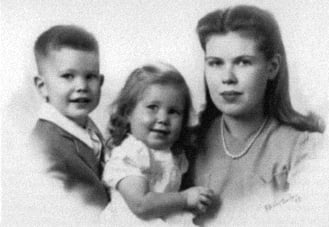
This thoughtful, educational life was very different from the other difficulties that my family was facing. With two kids, the budget was tight. Part of my father’s education was covered by the G.I. bill, but my mother’s had to be raised separately along with paying for other expenses. My father had started a lumber business after the war to provide additional income. The business was successful, providing just enough for us to eke by. Then, a problem came up. In one of the stands of trees that my father purchased, a large, productive still was producing bootleg alcohol for this dry portion of the state. As soon as the tree cutting began, the group operating the still approached my father. They offered him cash not to cut the trees and expose their substantial operation. My father, at some personal risk, informed the police, and the trees were promptly impounded (no longer allowed to be cut for the saw mill) by the judge handling the case. He was apparently on the payroll of the illegal distillery operation as some police must have been. This caused an immediate financial crisis for us, as much of the saw mills/lumber company funds were tied up in trees, which were to be cut down and then milled to lumber and sold. Suddenly there was a shortage of trees to mill. Needless to say, our lumber company was soon in bankruptcy. We quickly moved out of our house and in with my grandmother, while my parents struggled to finish their college courses and graduate.
Meanwhile, my father had migrated from law into engineering. I later wondered if it was due to the contrast between the spirit and the letter of the law as practiced in this lumber case or whether his natural talent and interest in engineering and mathematics emerged. Shortly after graduation, my father landed a job with the U.S. Geological Survey in hydrology (water resources). We were on the road to getting out of debt with no asset but our family education.
Soon, an opportunity opened up in the form of a USGS job in Alaska, a location where my father had served as a fighter pilot during World War II. He jumped at the chance to work in the field and its pioneering efforts. Our family moved to Alaska, piling all our belongings into a homemade trailer and making the trip up the Alaska-Canada highway. We felt like the early settlers going west in covered wagons to a new life and land. There were mishaps – failures of the trailer – and other adventures on the long trip north to the Matanuska Valley (in sight of Mt. McKinley). We were still very poor and did not have one of the new-fangled TV sets that could get reception from the few stations in Anchorage. Instead, I spent my time exploring the outdoors, viewing the night sky, and studying. By now (1954), I needed glasses due to the long hours reading and studying I did during the winters. My mother also worked, starting her career as an elementary school teacher. I was in the Palmer, Alaska unified school district from grades 2–6 where I received a good education. Many of my classmates were Eskimo and Indian orphans as the state orphanage was near by presumably a big step up from being left on an ice floe. The experience seemed like a great opportunity to meet people from all over the Valley and learn things. We only occasionally had to do the duck and cover drills in case of nuclear or air attack. In this isolated area, we felt fairly safe except for the occasional moose wandering onto the playground. Because the ground froze hard during the winter we could also ice skate at the low end. There I got my first classic lessons in conservation of angular momentum for spinning ice skaters (arms in and out) as well as learning not to stick my tongue on the cold metal figures of the playground equipment.
During this period my father showed me how to be an intrepid explorer as he regularly procured data for hydrology and hunting. We did not buy the meat we ate during our four years in Alaska but acquired our own from hunting and fishing. My father and his friend Frank Trainer would go into the wild and bring back whatever was in season: moose, mountain sheep and goats, caribou, and bears. We also had a large vegetable garden. Though the growing season was short, the light days were long. The Matanuska Valley is famous for its large vegetables. For example, one year that we lived there, a 40-lb (18 kg) cabbage won at the state fair. During the winter, moose would come down into our now frozen vegetable garden and dig out some of the remaining edibles.
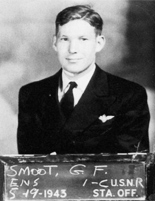
My father would also reconnoiter on field trips to measure the properties and flow of rivers, often having to chop through many feet of ice to get to the water in question. He invented a number of devices and techniques, which we were able to see. Eventually, word spread of his efficiency, and he was called to the research station in Columbus Ohio, and then later to headquarters in Washington, D.C. As a leader in the field, my father traveled worldwide to measure rivers and other water sources. Our family still has clippings of the time that my father went to Brazil to work with the local agency to make the first measurement of the water flow rate of the Amazon River. Shortly after that, he went to measure the Mekong River and its tributaries something new and fairly dangerous. He traveled to many places, and later worked for the World Bank on issues related to irrigation projects and water resources. The role model he provided and message he sent was: go anywhere and do anything necessary to get the data or the meat for meals.
My mother also was a tremendous role model. Though soft spoken, she continued to develop her career as a teacher. When we moved to Columbus Ohio, she entered the Masters Degree program at Ohio State and received credentials to teach science. I remember very well how she performed her teaching job, took care of my sister and I, and also went to night courses studying at Ohio State; this while my father was traveling. Some nights my sister and I accompanied my mother and studied in the library. Again, the importance that my parents attached to education, both by word and deed was apparent. While traveling, my father found a bargain used bookstore and over a number of visits, bought for me the complete Modern Library of what were considered the great books. At first I was encouraged to read these but soon eagerly awaited the arrival of the next batch.
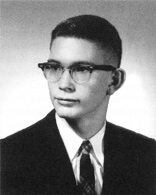
While I was in high school, Sputnik appeared in the October sky (1957), and the nation and world became interested in science and space. My mother tutored me in additional science and history, while my father drilled me in the basement, force-feeding trigonometry and introductory calculus courses that were not given at my high school. I also put together a crystal radio set and later, a transistor radio kit.
During this time, I worked to save money for college – as a paperboy for the Columbus Dispatch, mowing lawns, and working as a caddy at the Scioto Country Club (all while studying and reading). After three years of this work, I had barely enough money to pay for little more than my first semester at MIT. During my undergraduate years at MIT, I worked various jobs to help pay for my education, in addition to support from my parents and student loans. The hardest part was taking the rigorous courses and a heavy course load, but I wanted to take advantage of a good education. It was clear that MIT was definitely pushing us with as much information as we could soak up, and then some.
At the end of the four years, I received dual degrees in Mathematics and Physics along with the clarity that I really was going to be a physicist. I had come into college with a thirst for knowledge and an interest in many areas. I considered premed and other things but eventually gravitated to math and physics. At the time, MIT made every entering freshman take courses in math, chemistry, physics, and the humanities plus a choice of elective. Soon, it was clear to me that I enjoyed and did my best in mathematics and physics, and so focused in those areas. By the time four years had gone by, my interest in physics pulled ahead of mathematics. While I had a number of good and influential teachers in elementary and high school, when I got to MIT, I found professors who were also excited by the research at the forefront of knowledge and understanding. They had an attitude of anticipation and excitement about what the next day would bring and what challenges they could overcome.
My fellow students were much the same way and we studied hard. However, we had to let off steam in an MIT traditional way of hacks that is generally high-tech pranks and feats of technical derring-do. Some were simple, like welding rails in a 3-D cross in someone’s dorm room or filling a refrigerator completely full of Jell-O (you put it on its back and then right it carefully once the Jell-O gels). Some were more elaborate, like a steam catapult for hard-boiled eggs or water-balloon crossbow. One received peer kudos for technical difficulty.
We carried forward the occasional prank into graduate school. My fellow graduate student and research colleague, Orrin Fackler and I were working shifts together, putting together an experiment at Brookhaven National Laboratory’s AGS accelerator. We had determined that the most effective target for turning a positive kaon beam into a neutral kaon beam would be made of osmium. Now that was rare, more so than gold or platinum, and thus we did not think we could get it so were thinking of alternatives. Our advisor, Professor David Frisch said, “Your calculations look correct. I will go and personally sign out the osmium from the strategic metal and you can use it for your theses experiments.” This was an inspiring show of confidence in us and our willingness to do what was necessary for the experiment. Frisch was personally on the hook for a small cylinder of metal worth twice what his new car was.
No good deed goes unrewarded. While working a half-day shift 7 PM to 7 AM, we were preparing the target box to hold the new target that Frisch had brought down to Brookhaven after his Friday class. It turns out that it did not fit in the carefully designed target box because it had warped a bit during the welding process. Orrin and I discussed this and realized that we would have to spend the entire night hack sawing and filing down the inside portion of the target box. By early morning, we had a significant pile of silver colored aluminum chips and dust similar color to osmium. We knew that Professor Frisch would soon (typically 6:30 AM) come bounding in to see how much we had accomplished during the night (not much). I convinced Orrin that we should play a trick on Professor Frisch. When he came in enthusiastically greeting us, I wiped my brow as I finished screwing back together the target box and complained how hard osmium was to work with. I told him how it did not fit and how we had to saw and file on the osmium all night. Dave looked stricken with concern, but he knew I played pranks so he looked over at the always serious and more mature Orrin who added, “Yes, there was a lot to do but we worked hard to shave it down to have it ready for you today.” Dave now looked back with his hand over his heart. I responded, “What is the matter? Is it toxic?” Dave gasped, “No, but it is precious.” Orrin and I then confessed the prank, and after he recovered, Dave had a good laugh about it.
Though I was interested in many fields in physics, particle physics offered funds and opportunities for me to do a senior thesis. I was able to build equipment, take data, and learn things that no one had previously known. Soon I was hooked, and while accepted to a number of graduate programs, I chose to continue at MIT doing particle physics experiments. Working with researchers, including Professors Frisch and Osborne; other people in their groups; Kendall and Friedman; and later Professor Sam Ting, was an important experience in the rigor and attitudes of seeking the best science.
I was working on my senior thesis in the 1965–1966 academic year when I heard of the Penzias and Wilson discovery of the 3K Big Bang relic radiation. I was already interested in astrophysics, and paid some attention to the discovery, but I was busy with my schoolwork and research so I filed it away as something I had learned.
A few years later in 1967, Joe Silk was writing his paper on primordial fluctuations in the CMB (which was very influential for me) and Steven Weinberg began teaching his course at MIT that eventually became the book Gravitation and Cosmology. This informed me that there was something exciting and fundamental happening in this area. However, I was newlywed, finishing my thesis, and my wife Maxine was applying for graduate school in English Literature. I would soon need a postdoctoral scholar position, so I could not act right away. In 1970, I finished my Ph.D. at MIT and then went out seeking a new position. I was twenty-five years old. I interviewed at a number of places including a few positions at Berkeley, where I was persuaded by 1968 Physics Nobel Prize winner, Professor Luis W. Alvarez to choose Berkeley, and his group in particular, because they were willing to venture into completely new areas. This was also a position that would make good use of my newly acquired skills and knowledge.
A major reason that I came to Berkeley (University of California and the Lawrence Berkeley National Laboratory) was the I-can-do attitude along with the emphasis on first-rate science. There were many excellent researchers in Berkeley including a number of Nobel Laureates. Luis Alvarez was among the notables and it was his recruitment that attracted me so directly. However, there were many others whom I knew and interacted with besides Luis Alvarez including Emilio Segrè, Owen Chamberlain, Edwin McMillan, Glenn Seaborg, Don Glaser, Melvin Calvin, Yuan Lee, and more recently Steven Chu. There were many more outstanding scientists, engineers, and technicians that made Berkeley an excellent environment conducive to outstanding research. Interacting with such individuals provided many role models, along with the knowledge that these were real people who organized and applied themselves to do exceptional work.
I left MIT in 1970 and came to the University of California at Berkeley to work with Luis Alvarez on the NASA-funded High-Altitude Particle Physics Experiment (HAPPE, pronounced happy) at Lawrence Berkeley National Laboratory. The goal of HAPPE was to probe for interactions at higher energies than accelerators could produce at the time. The unfortunate Pacific Ocean crash of the HAPPE instrument, followed by the approval to construct a new high-energy accelerator (at what is now FermiLab) resulted in the reevaluation and new direction of the HAPPE program. Our goal was to design an experiment to find evidence of the Big Bang, which had become scientists favored explanation for the formation of the universe. The Belgian priest and astronomer Georges Lemaître first proposed the Big Bang theory in the late 1920s, after Edwin Hubble discovered that distant galaxies were rapidly receding from us; hence the universe was expanding. Its many critics, particularly Fred Hoyle, scornfully called the theory the “Big Bang” but the concept gained wide acceptance after 1964 when Arno Penzias and Robert Wilson of Bell Telephone Laboratories fortuitously discovered the cosmic background radiation – microwave remnants from the creation of universe. The existence of the cosmic background radiation was initially predicted by George Gamow in 1948, and eventually supported by other Big Bang theorists.
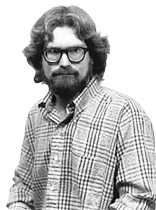
According to the basic Big Bang theory, 14 billion years ago our observable universe began with a rapid expansion of an extremely small but extraordinarily dense region in which energy and matter were one, and it has been expanding ever since. The initial subatomic particles and antiparticles arose from the primal energy, and eventually their daughters formed protons, neutrons, and electrons. After only 3 minutes, light nuclei formed. For the first 380,000 years, the temperature was too hot for the electrons to attach to the protons and nuclei to form atoms. The radiation that filled the universe could not travel freely without being scattered by the free electrons; therefore no light could escape and the universe was opaque. After 380,000 years of darkness, the universe cooled sufficiently for electrons to affix to nuclei, freeing radiation to escape (a process known as decoupling) and allowing light to become visible. The radiation that filled the universe during the period of decoupling continues (filling the universe) in the form of cosmic background radiation, but it has cooled from about 3,000 Kelvin at decoupling to less than 3 Kelvin. Kelvin is a scale of temperature in which 0 K, or -273.15° Celsius, is the temperature that molecules have no random thermal kinetic energy left. Following decoupling, the atoms joined to form molecules, and these aggregated under the force of gravity to create the universe known today.
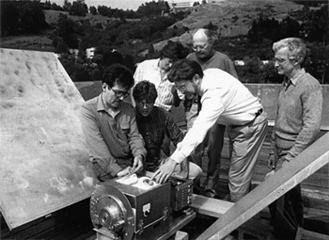
Our first balloon-borne detectors were designed to see if a portion of the cosmic rays were antimatter. We knew from particle experiments that whenever matter is created from energy, an equal amount of antimatter also forms. Simple extrapolation implies that the early Universe had essentially equal amounts of matter and antimatter present. So the primary question was: Where is the antimatter? We designed a balloon-borne superconducting magnetic spectrometer to search for antimatter in the incoming cosmic rays, the only sample of material we had from beyond the solar system. Beginning in 1971, I served as team field leader in such remote areas as Palestine, Texas and Aberdeen, South Dakota on several balloon launches designed to study the sky from a high altitude, away from misleading signals on the ground and produced in the intervening atmosphere. Our search for antimatter found no evidence of it, changing the question to: Why was there this slight part-per-billion excess of matter over antimatter in the early universe? Our limits for anti-carbon and anti-oxygen reached the one part per 10,000 level, and the observation was recognized in 1973 by the American Institute of Physics as one of the world’s twelve outstanding physics experiments of the year.
In 1973, I turned my attention back to the cosmic background radiation, which was thought to be relic from the Big Bang and it could be used to indicate whether the universe was rotating, as some had theorized, or simply expanding without rotation. It could test if the expansion was uniform in all directions and also should have residual traces from the primordial perturbations that eventually made clusters, galaxies, and eventually stars and planets. I chose to work on measuring cosmic background radiation partly because I knew this: whatever we learned would be fundamental. Regardless of what we found, our observations would tell us about the early universe. James (P.J.E.) Peebles‘s 1971 book Physical Cosmology helped convince my colleagues that this was a worthwhile area of research.
With the backing of Luis Alvarez and the help of NASA, we developed and used a differential microwave radiometer (DMR) mounted in a high-flying U-2 spy plane to study the cosmic background radiation in 1976. The DMR measured differences in temperature as small as one-thousandth of a degree in the microwave radiation between two points. It consisted of two rotating measuring horns at sixty-degree angles pointed through the upper hatch of the plane. The observations showed that the universe is not rotating and that it is apparently expanding with uniform speed in all directions. Those findings were important, and the only signal we found was a dipole anisotropy. The Doppler effect makes the radiation appear warmer in the direction towards which we are moving, varying smoothly to cooler in the opposite direction – forming a dipole pattern. This observation determines the direction and speed of movement. The most startling discovery was that it was in the opposite direction of our galaxy’s rotation. That dipole indicated that the Milky Way is moving at over a million miles per hour relative to the rest of the universe. This means that an object of enormous size (such as a supercluster of galaxies) must be exerting gravitational pull on our galaxy. Billions of years of acceleration brought it to this rapid speed.
Announced in 1977, astronomers regarded the discovery suspiciously, because most of them believed that objects were spread evenly throughout the universe. We won over skeptics by repeating the experiments in the Southern Hemisphere, eliminating the possibility that we had been misled by a location affect.
In a homogeneous universe, objects large enough to produce that much gravity could not have formed. The data implied that some regions of the universe are virtually devoid of galaxies while others are filled with billions of galaxies – forming superclusters. That revelation demanded a reassessment of the origin of the universe. In the era of decoupling, it was assumed that matter was evenly distributed throughout the universe, hence the cosmic background radiation (CMB). The CMB is an image of that time, and should show a uniform temperature (as tests had indicated). With the new knowledge of the uneven distribution of matter, scientists came to believe that for the universe to develop as it has there must have been some areas denser than others at decoupling, with the consequence that there should be variations in the temperature of the cosmic background radiation visible today.
Since 1974, I had worked on a proposal to NASA for a satellite to measure and map cosmic background radiation, in addition to the balloon-borne and U-2 experiments. Out of the 120 proposals submitted to NASA, my group and two others interested in cosmic background radiation were selected. In 1976, NASA told us to join forces. The collaboration was named the Cosmic Background Explorer, or COBE (pronounced COH-bee), which carried three instruments to examine the beginnings of the universe: (1) three DMRs similar to the U-2 (but more sensitive) to map the cosmic background radiation; (2) a far infrared absolute spectrophotometer (FIRAS) to measure the spectral curve of cosmic background radiation, which would tell if the CMB was truly from the Big Bang; and (3) the diffuse infrared background experiment (DIRBE) to look for cosmic infrared background – the glow from the earliest galaxies. It took six years to convince NASA that we knew what we wanted to do and knew how to do it. During that time, as head of the DMR team, I began commuting between Berkeley (where I was working on various ground-based, balloon-borne and the U-2 experiments) and NASA’s Goddard Space Flight Center, in Greenbelt, Maryland, where COBE was based.
NASA finally accepted the proposed mission and scheduled it for a late 1988 launch on the space shuttle instead of its original rocket concept, but after the January 28, 1986 Challenger shuttle tragedy, the COBE team was told that they would not have a place on future shuttles. Two other rocket mishaps in 1986 resulted in an indefinite postponement of all launches, leading the team to consider using a French rocket. Confronted by the possible embarrassment of having a major American science project launched on a French rocket, NASA gave the go ahead to launch COBE in 1989 on the last small Delta rocket, which required the size and weight of COBE to be greatly reduced. Having less than three years to redesign the satellite forced a hectic schedule. Scientists from the three instrument teams had to work closely with engineers to bring COBE to fruition. According to the Goddard Engineering Newsletter, “the transformation of COBE from [the space shuttle] to a Delta launch is probably one of the greatest engineering challenges ever undertaken by the [Goddard Space Flight Center].” On November 18, 1989, the $160 million COBE satellite was launched from Vandenberg Air Force Base in California. Controlled from Goddard, COBE traveled about 16,800 miles per hour in a polar orbit about 560 miles above Earth and completed a survey of the sky every six months.
The first important discovery showing that the cosmic background radiation resulted from the Big Bang came from the FIRAS instrument, led by Dr. John Mather. The radiation measured by FIRAS perfectly matched the blackbody curve, meaning that the CMB had a thermal origin in the early universe.
In early 1991, anisotropies at many angular scales became evident in the data from the DMRs. By fall of that year, evidence of smaller ripples, or wrinkles of temperature fluctuations, had been detected by the DMR team. In light of the many invalidated theories and discoveries, I was obsessed with detecting possible causes of error. I demanded secrecy until we were sure that we were seeing cosmic fluctuations instead of signals from the sun, moon, galaxy, the instruments themselves, or anything else. To inspire diligence in seeking errors, I offered anyone on the team two free plane tickets to anywhere in the world if they could prove a mistake had been made.
The scientific community grew restless waiting for the results, and there were papers stating that the Big Bang was in trouble since the temperature variations had not been found. There were heated arguments among the COBE team about whether the findings were ready for publication. In late 1991, we had become convinced that the analysis was correct, and had a program of tests and studies to ensure this. I wanted to check for one more possible source of error: radio interference from our galaxy that was greater and different from the meager amount we anticipated. There were already maps of our galaxy’s microwave emissions, but if they were wrong, then the DMRs’ data could be as well. Therefore, in November I led a team to Antarctica for a month to make our own celestial map and to check the brightness of the sky in a new area. Antarctica was chosen because in the cold, dry air, it has less interference from earthly signals. Even though it was austral summer and the sun never set, the working conditions were harsh. Oxygen was thin and the temperature could easily reach seventy-five degrees Fahrenheit below zero. Withstanding the elements, we confirmed previous celestial maps. After my return, I donned a tuxedo to signify and lead the formal portion of the review that certified the COBE DMR results were a success in terms of data quality, collection, and analysis. The review included NASA officials and COBE and DMR team members on the testing, checking, and progress of COBE DMR results. However, we held back on announcing the finding until the fluctuations could be extensively examined and characterized, and publications were ready with interpretation and back up.
This great care was necessary because of the technical difficulties of finding such a small signal in a large background. In Wrinkles in Time, I compared looking for the cosmic background radiation to “listening for a whisper during a noisy beach party while radios blare, waves crash, people yell, dogs bark, and dune buggies roar.” The key was removing unwanted signals from the picture to identify temperature fluctuations of a mere 1/100,000 of the CMB intensity. We examined the hundreds of millions of measurements in a myriad ways. The team confirmed the previously discovered dipole with relative ease, but identifying the smaller wrinkles proved difficult. The observed quadrupole was lower than anticipated compared to the higher order fluctuations (having smaller angular scale). Finally, removing the quadrupole effect from the data, I found that the observed fluctuations fit predictions for a scale invariant spectrum. To confirm this finding, I suggested to graduate student Charles Lineweaver to look at the data with the quadrupole removed, without telling him what he would find. He used a different version of the analysis program that he had written rather than the one I wrote. When Lineweaver left the office in the early morning hours, he slipped his results under my office door with the message: “Here are the plots you asked for. Eureka?” They agreed precisely with my own calculations. Everything had fallen into place.
After three more months of intensive work, and fine-tuning the details and text, the team submitted manuscripts for publication in the Astrophysical Journal and announced the results at a meeting of the American Physical Society in Washington, D.C., on April 23, 1992. I had the lead talk at the meeting and was followed by six other COBE members. The announcement that COBE had not only detected a quadrupole effect, the first evidence of structure in the early universe, but also smaller ripples in the temperature of the cosmic background radiation that are consistent with Big Bang theory, stunned the audience of scientists and touched off a media frenzy rarely seen at scientific conferences. Much of the attention and excitement outside of the scientific world focused on my comment at the press conference that “If you’re religious, it’s like seeing God.” Michael Turner, an astrophysicist at the University of Chicago, declared, “They have found the Holy Grail of cosmology,” and Stephen Maran, the editor of the Astronomy and Astrophysics Encyclopedia, said “It’s like Genesis.” The commotion was capped off by a Newsweek headline reading “The Handwriting of God.” These creation analogies brought widespread notice and discussion of our findings.
The detected ripples in space-time, which measure about a part in 100,000 or 30 millionths of a degree differences in temperature, started as small lumps (quantum fluctuations) but over time expanded to the immense size that COBE observed. The denser areas of the early universe, which appear slightly cooler in the cosmic background radiation, would have had sufficient gravity to attract more matter. This resulted in a snowball effect, in which more matter causes more gravity that attracts more matter, and the lumpy areas and voids become more and more defined.
The major importance of the COBE team’s findings is that it gives quantitative measures for what had been merely speculation, providing firmer ground on which to base further study. The discovery of wrinkles in spacetime neither confirms nor refutes many of the abundant variations of the Big Bang theory. Indeed, while weeding out some theories, the findings have invigorated many theories and new concepts, with scientists arguing over whether the wrinkles offer proof or refutation. This richness has resulted in a blossoming of the field and attracted many new young people to the discipline of cosmology. Successive experiments, including the satellite missions WMAP and Planck, have exploited these fluctuations as a tool to understand the properties and evolution of the universe with unprecedented clarity and precision.
In the years following this discovery and especially since receiving the Nobel Prize in 2006, I have seen that it is now my turn to be a mentor and role model as well as a spokesperson supporting basic science research in general. I want to encourage the next generation and hand over a science enterprise to my successors, which is as good or better than the excellent one I came into as a young scientist.
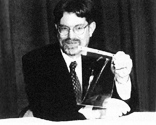
This autobiography/biography was written at the time of the award and later published in the book series Les Prix Nobel/ Nobel Lectures/The Nobel Prizes. The information is sometimes updated with an addendum submitted by the Laureate.
George F. Smoot died on 18 September 2025.
Nobel Prizes and laureates
Six prizes were awarded for achievements that have conferred the greatest benefit to humankind. The 14 laureates' work and discoveries range from quantum tunnelling to promoting democratic rights.
See them all presented here.
